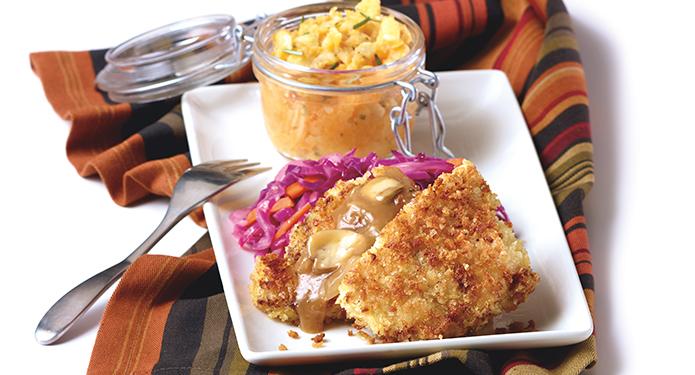Attractive presentation requires the kitchen and dining room to work together.
When a beautiful plate of food passes through the dining room, heads turn and murmurs of “I’ll have that” echo among the tables. Perfect plating sets expectations for the entire meal. After all, people are known to eat with their eyes first.
In healthcare and residential settings, attractive presentation carries rewards for diners and operators. Thoughtfully plated food enhances appetites, and eating well promotes healing and better nutrition. Furthermore, when people are excited about eating, it means less waste and can result in higher satisfaction ratings on patient and resident surveys.
Dietitians of Canada suggests that the taste, texture, and appearance of foods is directly linked to improved quality of life for long-term care residents. Research also shows that improving meal presentation can lead to increased food intake—extremely important when taking into consideration the high risk of malnutrition and dehydration within the elderly population.
Avoid meal monotony
No one wants to eat food that looks or tastes the same every day, even if it’s a favourite meal. Adding a whirl of cream, using a squeeze bottle to apply sauce or adding a pop of colour with a garnish can make a familiar dish feel fresh. But no matter what plating technique is employed, there is one factor that makes a big difference to diners.
“Food served at an appropriate temperature is a benchmark for appeal,” according to Gordon Food Service Tabletop and Disposables Product Specialist Jean Van Horn.
She suggests utilizing plate warmers or plate dispensers with self-leveling plate silos to add efficiency on the prep line and help keep food at the intended temperature. And don’t overlook keeping the dish at temperature while bringing it to the table.
“Covering plates, mugs and bowls with lids instead of plastic wrap is one way to improve presentation that also improves appetites,” explains Amy Caudle, Marketing Specialist at Gabriel Group in Grand Rapids, Michigan.
Perfectly prepared, visually striking and well-presented meals require a balance. The back-of-house and front-of-house teams need to work in harmony, from the choice of plate, to the arrangement of food to the table setting. Many plating improvements can be accomplished simply and inexpensively.
Back-of-house considerations
Plate like Picasso. Take the ordinary protein, vegetable and starch and make it extraordinary. Placing each component close together in the centre of the plate creates focus and unity. Adding height or layering adds pizzaz, but Van Horn cautions kitchens to only use this technique if diners have the motor skills to eat with dignity. A drizzle of olive oil or sauce at the edge of the plate lends a tasty touch of personality.
- Be handy with tools. Inexpensive equipment can enhance the way food is plated.
- Squeeze bottles—use to create swirls, lines, dots, and zig-zag patterns with sauce.
- Pastry bags—use to pipe whipped cream or mashed potatoes.
- Powdered sugar shaker—use to sprinkle sugar or cocoa powder.
- Peeler—use to create vegetable strips.
- Spoon and forks—use to spread sauces or create a spoon and fork outline with cocoa powder.
Garnish with purpose. Serving brown oatmeal or scrambled eggs every morning gets boring. Try topping hot cereals with chopped nuts, cinnamon, fresh fruit or peanut butter. A sprinkle of chives or diced tomatoes looks great over egg dishes. On dinner entrees, a sprig of parsley adds colour, but it’s a waste if it just gets set aside. Julienned vegetables, sliced fruit, nuts and diced herbs add flavour and flair to the plate.
Soup up soups. A dollop of yogurt, a swirl of cream or a sprinkle of fresh herbs and spices dress up the desirability of a warm bowl of soup.
Dress up desserts. Cut desserts such as sheet cakes into whimsical shapes and sizes. Many sheet cakes come with a template for creative cuts. Toppings—a mound of whipped cream, a dusting of sugar or cocoa powder, a sprinkle of shaved chocolate, a scattering of berries—also add zest.
Front-of-house considerations
Choose the right plate. The colour of the plate makes a difference, especially for people in memory care or with vision and depth perception issues. “A red plate can help foods stand out—especially light-coloured foods like poultry, pork, potatoes and corn,” says Gordon Food Service Tabletop Analyst Carol Klein. She also recommends using plates with rims or raised edges to help diners scoop up food.
Size up for success. A nine-inch plate is not overwhelming, Van Horn suggests, and provides the sense of a full plate for those with smaller appetites.
Be best in glass. Drinkware needs to be lightweight, and you don’t want to worry about breakage. “Plastic options are now available that look like glass and are very lightweight,” Klein says. Some also have measuring marks on them that help your staff know how much liquid is poured and consumed.
Get a grip on utensils. Flatware and serving utensils must be easy to hold and lightweight, Van Horn advises. “Heavy pieces are not conducive to guest participation,” she notes.
Keep guests focused. White tablecloths are nice, but placemats help with spatial factors. The colour of the placement can help diners frame the plate and identify which utensils, napkins and glasses are theirs.
Think outside the table. Presentation is important at the hydration cart or snack station, Klein points out. An attractive dispenser or well-plated snacks with disposable cups, bowls and napkins can encourage hydration and nutrition between meals.
Enhancing the experience
The appearance and presentation of food affects the entire operation. There’s three meals a day, food served at activities and snacks available all day. Residents and guests notice foodservice, Klein says, and it shapes their overall impression.
An upscale community will naturally want to have upscale dinnerware. But all communities want to make the right impression with table service that’s flexible, durable and affordable. Whether an operator is just starting out or converting to new dinnerware, Klein recommends using upscale everyday plates and more budget-friendly complementary pieces like mugs and bowls to balance presentation needs and cost concerns.
“Communities are in the business of trying to attract people, so they can’t afford to have unattractive plates or unappealing food,” Klein points out. “Both have to work together to create the right atmosphere.”
Plating How-To List
Van Horn points to these things chefs do to make the best impression:
- Visualize a clock. Put protein on the plate at the 2 o’clock position; vegetables at 6 o’clock; starch at 10 o’clock.
- Think about colour, contrast. Light-colour food on white plates need a pop of colour, and foods with varying textures add appeal.
- Pay attention to details. Are the carrots sliced on a diagonal, in discs or julienned? Know what is easiest for guests to consume.
- Maintain food’s integrity. Place sauce under the protein to anchor it and not cover it. Plate fried foods last so they keep their crunch.
- Utilize tools. Brushes, needlepoint tongs and squeeze bottles can help add an artistic touch when you need it.

























